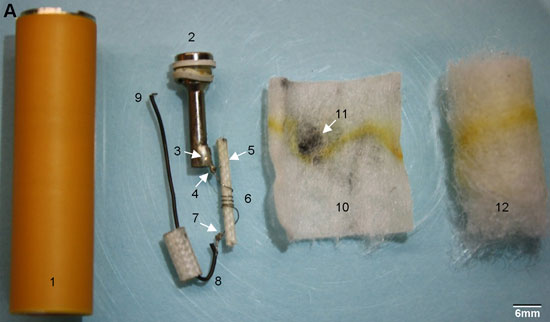| Mar 28, 2013 |
Electronic cigarette smoke contains more metal nanoparticles than tobacco smoke
|
|
(Nanowerk News) Electronic cigarettes (EC) deliver aerosol by heating fluid containing nicotine. Cartomizer EC combine the fluid chamber and heating element in a single unit. Because EC do not burn tobacco, they may be safer than conventional cigarettes. Their use is rapidly increasing worldwide with little prior testing of their aerosol.
|
|
A new study led by Prue Talbot, Professor of Cell Biology at the University of California, Riverside, and Director, UCR Stem Cell Center and Stem Cell Core Facility, tested the hypothesis that EC aerosol contains metals derived from various components in EC ("Metal and Silicate Particles Including Nanoparticles Are Present in Electronic Cigarette Cartomizer Fluid and Aerosol").
|
 |
| Cartomizer anatomy. (A) A dissected cartomizer. 1 = mouthpiece, 2 = air tube, 3 = solder joint between air tube and thick wire, 4 = solder joint between thick wire and filament, 5 = wick, 6 = filament, 7 = solder joint between the filament and thick wire, 8 = thick wire, 9 = solder joint where the thick wire would attach to the mouthpiece, 10 = inner fibers, 11 = black area on inner fibers, 12 = outer fibers with yellow electrophoretic band. (© PLOS ONE)
|
|
Among their findings was that cartomizer fluid with tin particles was cytotoxic in assays using human pulmonary fibroblasts. The aerosol contained particles >1 µm comprised of tin, silver, iron, nickel, aluminum, and silicate and nanoparticles (<100 nm) of tin, chromium and nickel. The concentrations of nine of eleven elements in EC aerosol were higher than or equal to the corresponding concentrations in conventional cigarette smoke. Many of the elements identified in EC aerosol are known to cause respiratory distress and disease.
|
|
The team concludes that the presence of metal and silicate particles in cartomizer aerosol demonstrates the need for improved quality control in EC design and manufacture and studies on how EC aerosol impacts the health of users and bystanders.
|

